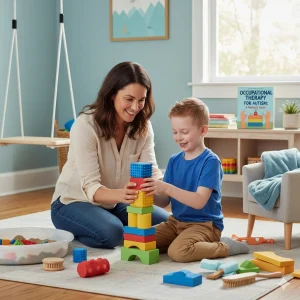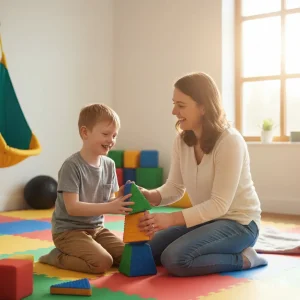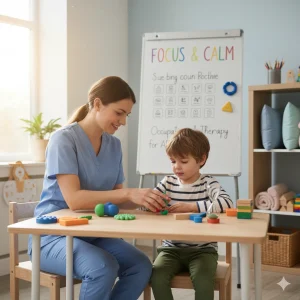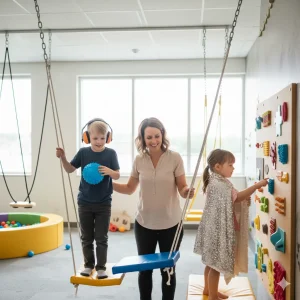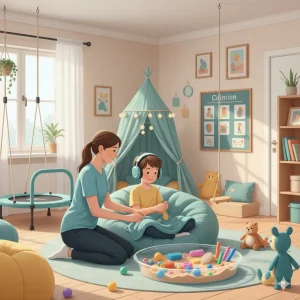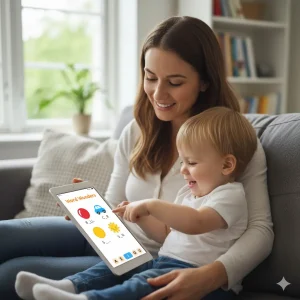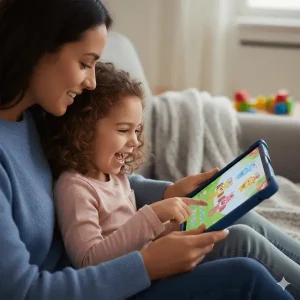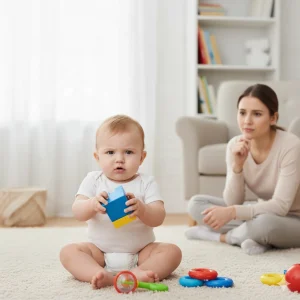Is My Child Just a Late Talker or Showing Signs of a Delay?
By Wellness Hub
Last Updated: August 1, 2025
“Why isn’t my toddler talking yet?”
It’s one of the most common—and nerve-wracking—questions parents ask. While some children seem to chatter non-stop by their second birthday, others speak only a handful of words or none at all. If your child isn’t meeting expected milestones, you may start to wonder:
Is my child a late talker or is it something more serious—like a speech delay or even autism?
Understanding the difference between a late talker or speech delay can help you take the right steps early. In this guide, we’ll explore speech milestones, red flags to watch for, and helpful tools like speech therapy apps and early intervention support.
Free Speech Help for Kids
Concerned about speech delays? Book a free consultation with our expert speech therapist and get guidance tailored to your child’s needs.
What Is a Late Talker?
Not every toddler follows the same timeline when it comes to talking. While some kids start putting words together before they turn two, others take a little more time to find their voice. These slower-to-speak children are often referred to as “late talkers.”
Who Is Considered a Late Talker?
A late talking toddler is typically between 18 to 30 months old and has a limited vocabulary but is otherwise developing normally in other areas like motor skills, social interaction, and play. For example, a child who understands what you’re saying, points to objects, follows instructions, and gestures—but says very few words—may be a late talker.
Late talkers often:
- Have fewer than 20 words by 18 months
- Speak fewer than 50 words and don’t combine two words by age 2
- Seem to understand more than they can say
- Use gestures (like pointing or waving) instead of words
This can be confusing for parents because a toddler not talking but understands everything may appear perfectly fine. In fact, many families say, “He knows what we’re saying—he just doesn’t talk back yet!”
Speech Milestones: What’s “Normal”?
Understanding the typical speech and language milestones can help you spot if your toddler is truly behind or just on the slower end of typical development:
- By 18 months:
- Says around 10–20 words
- Uses simple gestures (like pointing)
- Can understand and follow simple directions like “Give me the ball”
- By 24 months:
- Vocabulary grows to 50+ words
- Starts combining two words like “want milk” or “go park”
- Begins to name familiar people and objects
- By 30 months:
- Uses short phrases and starts forming questions
- Understands action words like “run” or “eat”
- Begins to use pronouns like “me” and “you”
So, when should my toddler start talking clearly? Most children begin to speak clearly enough for familiar listeners by the age of 2.5 to 3 years. If your child is approaching this age and still struggles with word use or clarity, it may be time to look deeper.
Real-World Example
Take Arjun, a cheerful 2-year-old who plays well with his toys, follows commands like “bring your shoes,” and loves to gesture—but only says about five clear words. His parents thought he was just a “quiet kid,” but after speaking with a speech therapist, they realized he was showing signs of a language delay and started early intervention.
Signs of a Speech Delay
It’s not unusual for parents to wonder:
“Is my child a late talker, or is there something more going on?”
While late talking can be part of a child’s unique development path, sometimes it’s a sign of a deeper issue—like a speech delay. Understanding the signs of speech delay can help you act early and get the right support when it matters most.
What Is a Speech Delay in Toddlers?
A speech delay means your child isn’t meeting typical speech and language milestones for their age. Unlike late talkers, who often catch up on their own, children with a speech delay may continue to struggle with speaking, understanding, or using language socially without professional help.
Here are some key signs of speech delay in toddlers:
- No babbling by 12 months
- Fewer than 10 words by 18 months
- Not combining two words by age 2 (like “want toy”)
- Doesn’t follow simple instructions like “sit down” or “come here”
- Rarely imitates words or sounds
- Doesn’t point or gesture to communicate
- Has difficulty naming familiar objects or people
If your toddler doesn’t try to repeat what you say, or seems frustrated but can’t express what they want, these may be early red flags.
Late Talker vs. Speech Delay: What’s the Difference?
Let’s break it down in simple terms:
| Late Talker | Speech Delay |
|---|---|
| Understands most things | Struggles to understand simple directions |
| Uses gestures to communicate | Limited use of gestures or eye contact |
| May not speak much, but tries to imitate sounds | Rarely imitates or engages in sound play |
| Often has a family history of late talking | May be linked with developmental concerns |
| Catches up with time or basic support | May require professional speech therapy |
Knowing the difference between “just a late bloomer” and a potential delay can reduce stress and help you make more informed decisions.
Read more: Speech Delay vs Late Talker: Signs, Differences and Next Steps
Real-Life Example
Meera’s 2.5-year-old daughter, Anika, loved music and was playful—but didn’t say more than a couple of words. While she smiled and pointed, she wouldn’t imitate words, even with prompting. Meera kept asking herself, “Is my child a late talker or something more?” After a consultation, the therapist confirmed a mild speech delay. Early intervention helped Anika start putting two words together within months.
Speech Delay vs Autism – Key Differences
When a toddler isn’t speaking as expected, it’s natural for parents to feel concerned. You may begin to ask,
“Is this just a language delay, or could it be something like autism?”
While both may involve delayed speech, there are key differences between the two. Understanding these can help you spot whether your child simply needs extra time—or may benefit from an evaluation for autism spectrum disorder (ASD).
What’s the Difference Between a Language Delay and Autism?
A language delay typically means your child is behind in speaking, but shows typical development in other areas like play, social connection, and understanding. A child with autism, however, may have broader challenges that go beyond language—especially in the way they interact, connect, and communicate.
In simple terms:
A child with a language delay wants to connect but struggles to find the words.
A child with autism may have less interest in connection or struggle to communicate in typical social ways.
Early Signs of Autism Communication Difficulties
While every child with autism is different, here are some early signs of autism-related communication issues:
- Limited eye contact
- Rarely responds to name being called
- Doesn’t point to show interest (e.g., “look at that plane”)
- Few or no gestures (like waving or nodding)
- Doesn’t bring you objects to share joy
- Repeats phrases without meaning (echolalia)
- Focuses more on objects than people
- Struggles with pretend play or interactive games
- Delays in both understanding and using language
These are often part of the broader early signs of autism communication, and may show up before age 3.
Comparison Table: Language Delay vs Autism
| Feature | Language Delay | Autism |
|---|---|---|
| Social engagement | Active, enjoys playing with others | Limited or unusual social interaction |
| Eye contact | Maintains eye contact | May avoid or have fleeting eye contact |
| Gestures | Points, waves, gestures to express needs | Rarely uses gestures or points to share interest |
| Understanding | Understands most words and directions | Often struggles with comprehension |
| Interest in people | Seeks attention, enjoys interaction | Prefers objects or routines over people |
| Play style | Engages in pretend play | Difficulty with pretend or imaginative play |
| Speech progress | Delayed but typically improves with support | May have uneven or very limited progress without therapy |
| Communication focus | Wants to communicate but struggles | May show limited desire to communicate socially |
Know more: Is It Speech Delay or Autism? Understanding Your Child’s Communication Development
Why This Difference Matters
Recognizing the signs of autism in speech early can lead to faster diagnosis and more tailored intervention. Some children may have both a language delay and autism, so an accurate assessment by a speech-language pathologist or developmental pediatrician is essential.
Even if you’re unsure, trust your instincts. If something feels “off,” early screening tools and autism apps can help track your child’s social and speech milestones at home.
Digital Help – Best Apps for Speech & Communication
In today’s digital world, support for your child’s speech and communication doesn’t have to begin in a clinic—it can start right at home. Thanks to smart, research-backed tools, many parents are now turning to speech therapy apps and autism apps for toddlers to help their children practice speaking, listening, and understanding in fun, interactive ways.
These apps aren’t meant to replace professional therapy—but they can be a powerful supplement, especially during the early years when every word counts.
Why Use Speech Therapy Apps?
If you’ve ever wondered, “Are there apps to help my toddler talk?”—the answer is a big yes.
Today’s best speech therapy apps are designed to:
- Encourage first words and basic vocabulary
- Model correct pronunciation with visual and audio cues
- Build listening and comprehension skills
- Offer speech therapy games for 2 year olds that feel more like play than practice
- Allow parents to track progress and stay involved
- Provide structured routines that support language-building every day
These tools are especially helpful for families who want to bring therapy into daily routines—without needing extra screens or complex setups.
Top App Recommendation: The BASICS App
One of the most trusted tools in India and beyond is the BASICS App, a therapist-designed platform for children with speech delays, communication challenges, or early signs of autism.
Key Features of the BASICS App:
- Simple, guided activities tailored to toddlers and preschoolers
- Videos, flashcards, and interactive tasks based on developmental goals
- Support for speech clarity, word building, imitation, and social interaction
- Built-in tracking so parents and therapists can monitor progress
- Designed for home use—no special training required!
Whether your child is struggling to say their first words or needs extra help using sentences, BASICS is among the best speech therapy apps to have in your parenting toolbox.
Support for Autism and Communication Challenges
Many autism app for toddlers also integrate visual schedules, emotion recognition games, and daily routine support—all of which help children who may find verbal communication difficult.
Apps like BASICS focus on:
- Building joint attention (a core challenge in autism)
- Increasing eye contact through engaging video prompts
- Helping toddlers understand cause-and-effect in conversations
- Making communication feel rewarding, not overwhelming
When used consistently alongside therapy or everyday playtime, these apps empower both parents and children to make meaningful progress—one word at a time.
Real-Life Story
Rekha, a mother of a 2.5-year-old boy with delayed speech, started using the BASICS App after a recommendation from her therapist. “He didn’t speak much before,” she says, “but now he names animals, asks for things, and even greets family members. The best part? We do it together at home, every day.”
Tip:
Want to try it yourself? Explore the BASICS App to start your child’s personalized speech journey today—with fun games, clear visuals, and expert-approved guidance.
When to Seek Help From a Professional
As a parent, it’s natural to wonder if your child is just taking their time—or if they may need a little extra support. While all children develop at their own pace, there are moments when trusting your instincts and seeking expert help can make all the difference.
Knowing when to worry about speech is less about hitting exact word counts and more about observing your child’s overall communication patterns, responsiveness, and progress.
Red Flags That May Signal a Need for Evaluation
Here are some signs that may suggest it’s time to speak with a speech-language pathologist (SLP):
- No babbling or cooing by 12 months
- Not saying any words by 16–18 months
- Fewer than 50 words and no two-word phrases by 2 years
- Doesn’t follow simple directions like “Give me the ball”
- Difficulty imitating sounds or actions
- Rarely gestures, points, or shows interest in communication
- Speech is unclear even to familiar listeners after age 3
- Frustration or tantrums due to not being understood
If your child shows several of these signs, don’t panic—but don’t wait and see either. Early support leads to better outcomes.
What Happens During a Speech Delay Diagnosis?
When you visit a pediatrician or SLP, the first step is often a developmental screening. Your child’s doctor will ask about their communication milestones, play behaviors, and general development. They may refer you to a speech-language pathologist for a more in-depth evaluation.
An SLP uses standardized assessments to evaluate:
- Receptive language (what your child understands)
- Expressive language (what your child can say)
- Articulation (clarity of speech sounds)
- Social communication (use of gestures, eye contact, turn-taking)
- Play skills (how your child uses toys and engages with others)
They also refer to a language development milestones chart to compare your child’s progress to typical age expectations.
These assessments are gentle, play-based, and tailored to each child’s comfort and attention span.
Why Early Support Matters
The earlier a speech or language delay is identified, the easier it is to intervene—and the better the chances of helping your child catch up.
Research shows that children who begin therapy early (especially before age 3) often make faster, more lasting improvements. And with the right tools, like parent coaching, speech therapy apps, and guided home practice, progress can happen in natural, everyday moments.
A Parent’s Perspective
Sonal noticed her 2-year-old daughter wasn’t using many words and often got upset when she couldn’t express herself. Their pediatrician referred them to an SLP, who confirmed a mild expressive language delay. “I’m so glad we didn’t wait,” Sonal says. “Just a few months into therapy, and she’s already putting words together!”
What You Can Do at Home
If you’re concerned about your child’s speech development, the good news is that you can make a big difference—right at home. You don’t need fancy equipment or specialized training. With just a few consistent routines and a lot of love, you can create a language-rich environment that encourages your child to speak more and communicate better.
Knowing how to encourage your toddler to talk starts with simple, meaningful interactions that turn everyday moments into learning opportunities.
Also read: 10 Creative Ways to Make Speech Therapy Fun
Talk Throughout the Day
The most powerful tool you have is your voice. Talking to your child during everyday activities helps them hear new words, understand how language works, and feel included.
Here are some easy ways to do this:
- Narrate everything: While cooking, dressing, or playing, describe what you’re doing: “I’m cutting the apple,” “Let’s wash your hands,” “We’re putting on your shoes.”
- Repeat and expand: If your child says “ball,” you can say, “Yes! A big red ball!”
- Ask open-ended questions: Even if they don’t respond yet, ask things like, “What do you see?” or “Where should we go next?”
- Pause and wait: Give your child time to answer or attempt a word instead of filling in the silence.
Activities to Boost Toddler Speech
Play is one of the best ways to support language development—especially when it’s fun, simple, and interactive. Here are some tried-and-true activities to boost toddler speech at home:
- Name That Toy: Place a few favorite toys in a basket. Ask, “What’s this?” and name it clearly if they don’t respond. Over time, pause and wait to see if they start naming them first.
- Laundry Talk: Turn chores into language time. Ask questions like “Whose shirt is this?” or “What color is this sock?”
- Storytime: Read picture books with large, clear images. Point to items and name them. Use books with repetitive phrases that your child can try to finish.
- Echo Game: Make a silly sound or word and encourage your toddler to repeat it. This builds imitation and attention skills.
- Sound Play: Play with animal toys or cars and make sounds together—“moo,” “beep,” “vroom.” These sounds often come before actual words.
Use Printables & Milestone Checklists
To stay on track and make learning visual, use printable resources like:
- A speech milestone checklist (for 12–36 months) to track progress
- First word flashcards with simple pictures and labels
- Daily activity charts that prompt speech goals like “Name 3 animals” or “Ask for help”
These tools help you stay consistent while making speech practice part of your routine. They’re especially helpful for visual learners and toddlers who thrive on structure.
A Gentle Reminder
No one knows your child like you do. Even small, daily efforts—talking more, playing intentionally, and responding with warmth—can lay the foundation for strong communication skills. And remember, every word your child hears from you brings them one step closer to saying their own.
Download Our Free Checklist: Is It Delay or Late Talking?
Still wondering whether your child is just a late bloomer—or showing signs of a developmental delay? You’re not alone. Many parents struggle with knowing exactly what’s “normal” and what’s not when it comes to toddler speech.
That’s why we’ve created a free, easy-to-use PDF resource:
“Toddler Speech Milestones Checklist: Is It a Delay or Just Late Talking?”
This simple printable will help you:
- Track key speech and language milestones from 12 to 36 months
- Identify red flags to discuss with your pediatrician or therapist
- Understand the difference between a late bloomer and a developmental delay
- Feel more confident in knowing when to act—and when to wait
- Make notes and observations you can bring to your next check-up
Conclusion
Not sure if your toddler is just a late talker or showing signs of a speech delay? Don’t panic—but do keep an eye on their milestones. Early support can make a big difference. If your child isn’t talking much or seems behind, it’s okay to ask for help. Try the BASICS App for fun, expert-approved speech activities you can do at home. You’ll also get tips, progress tracking, and therapy support if needed.
Frequently Asked Questions:
1. What age is considered late for a toddler to start talking?
By 12 to 15 months, most toddlers say simple words like “mama” or “ball.” By 18 months, they typically use 20 or more words. If your child isn’t using any words or only says a few by this age, they may be a late talker. It’s also important to see if they try to communicate using gestures, sounds, or pointing. If not, it could be a sign of a speech delay.
2. How do I know if my toddler has a speech delay?
You might notice signs like:
- No babbling by 12 months
- Fewer than 10 words by 18 months
- Not putting two words together by age 2
- Difficulty following simple instructions like “come here”
- Trouble copying sounds or words
These are common signs of speech delay in toddlers. If your child understands what you say but doesn’t speak much or gets frustrated when trying to talk, it’s a good idea to get them checked.
3. Is it normal for a 2-year-old not to talk clearly?
At age 2, many children are still learning how to form words clearly. Mispronunciations are common. But by age 2.5 to 3, they should be speaking well enough for family members to understand most of what they say. If your child only uses a few unclear words or doesn’t try to talk at all, it could point to a speech delay or developmental delay.
4. What is the difference between a late talker and a speech delay?
A late talker usually understands well, plays normally, and uses gestures like pointing or waving—but just speaks less than expected. A child with a speech delay, on the other hand, may struggle with both understanding and speaking. They may not imitate words, gestures, or respond to simple questions. Late talkers often catch up on their own, while speech delays often need help from a speech therapist.
5. Can speech delay be a sign of autism?
Sometimes, yes. Many children with autism show communication delays early on. Besides late talking, they may avoid eye contact, not respond to their name, not point to things, or repeat the same words over and over (echolalia). However, not every child with a speech delay has autism. If you notice multiple signs—especially related to social interaction—it’s a good idea to get an evaluation.
6. When should I worry about my toddler’s speech?
You should speak to a pediatrician or speech-language pathologist if your toddler:
- Doesn’t babble by 12 months
- Doesn’t say any clear words by 16–18 months
- Can’t follow basic instructions like “give me the ball”
- Has fewer than 50 words and isn’t combining words by age 2
- Gets frustrated often because they can’t express themselves
These are important red flags for a possible speech delay diagnosis.
7. How can I help my toddler talk more at home?
You can do a lot to support your child’s speech at home:
- Talk during everyday activities (e.g., “We’re brushing your teeth now”)
- Read picture books and label objects
- Play games that involve naming things or making sounds
- Repeat what your child says and add more (e.g., Child: “Car” → You: “Yes, red car!”)
- Use apps to help toddlers talk, like the BASICS App, which has videos and games designed by experts
8. Are there good apps to help toddlers with speech delay?
Yes! There are many helpful speech therapy apps for toddlers. The BASICS App is highly recommended for children with speech delays or signs of autism. It offers short, fun activities, flashcards, and speech therapy games that can be done at home. These apps are not replacements for professional therapy but can support daily learning and give parents tools to work on communication every day.
9. What should I expect during a speech delay evaluation?
During a speech delay evaluation, a speech-language pathologist (SLP) will assess how your child:
- Understands and follows directions (receptive language)
- Uses words and sounds (expressive language)
- Plays and interacts socially
- Uses gestures, facial expressions, and imitation
They may use a language development milestones chart to compare your child’s progress with typical expectations. It’s all done through play and conversation to make your child feel comfortable.
10. Can speech delay go away on its own?
Some late talkers do catch up by age 3 without therapy. But if your child shows multiple signs of a delay, or isn’t improving over time, it’s best not to wait. Early help—like speech therapy or home-based activities—can make a big difference in your child’s progress. Even small efforts at home can help build confidence and communication skills over time.
About the Author:
Anuradha Karanam
Speech-language pathologist (7+ years of experience)
Anuradha Karanam is a skilled speech-language pathologist with over 6 years of experience. Fluent in Tamil, Telugu, Hindi, and English, she specializes in parent counseling, speech sound disorders, fluency assessment, and speech-language evaluations. Anuradha excels at working with children with developmental disorders, offering creative and effective therapy programs. Currently, at Wellness Hub, she holds a BASLP degree and is registered with the RCI (CRR No A85500). Her patience, ambition, and dedication make her a trusted expert in her field.
Book your Free Consultation Today
Parent/Caregiver Info:
Client’s Details:
* Error Message

